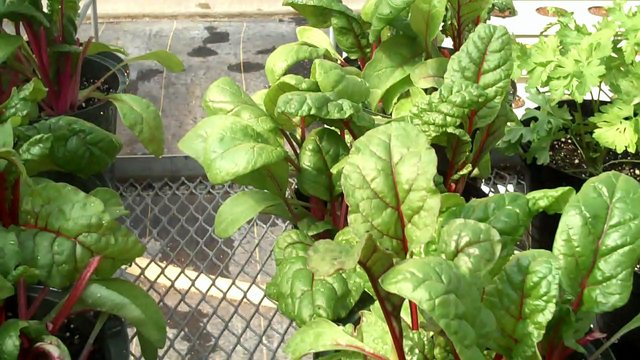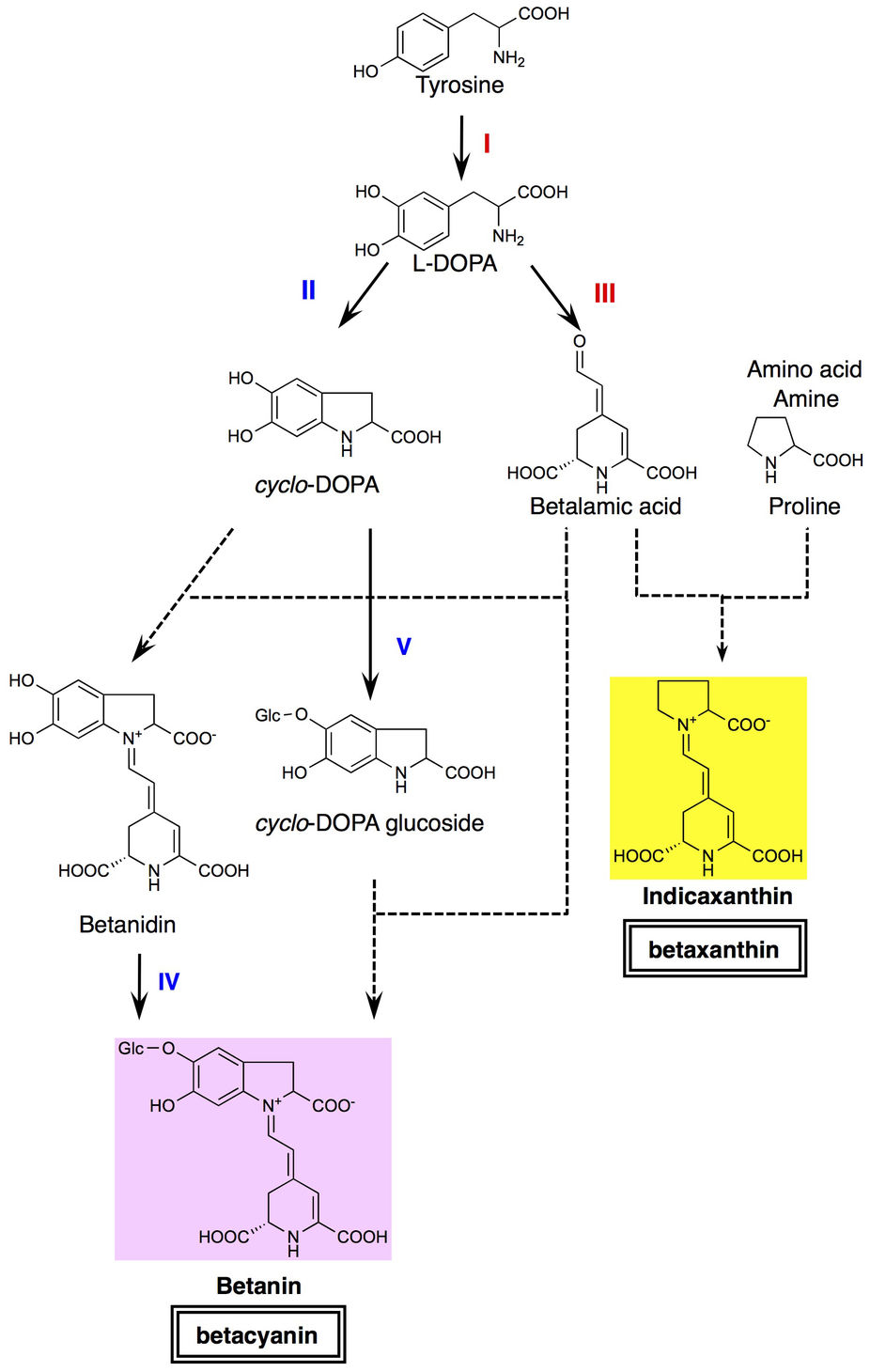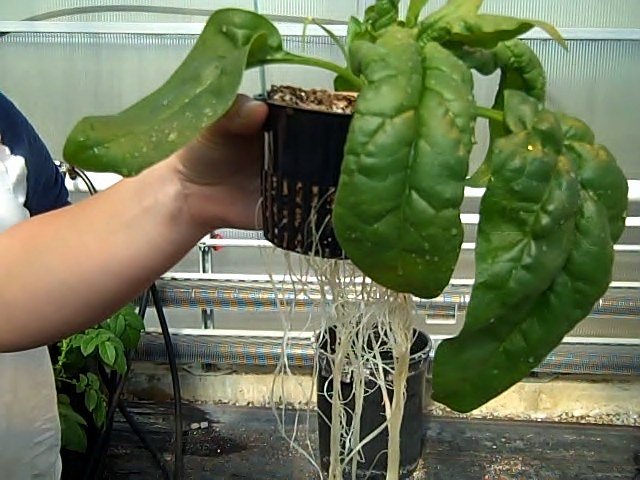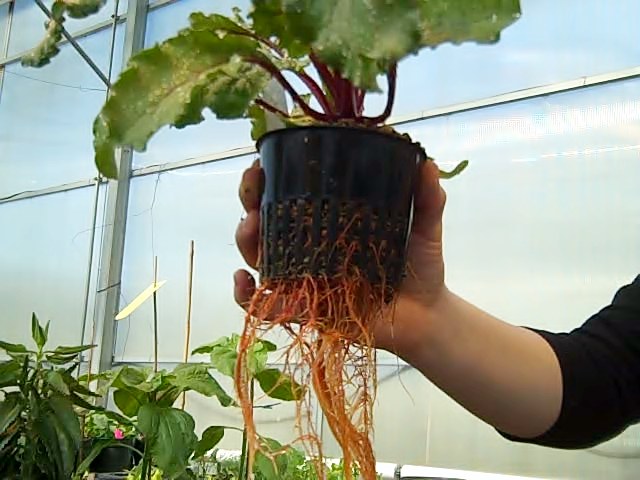Betalains - Unusual Plant Pigments
Most red, blue and purple plant pigments are anthocyanins which are derived from the amino acid phenylalanine. The Caryophyllales (the order of angiosperms that includes the insectivorous plants Venus flytrap, sundews and pitcher plants discussed in my previous posts) however, shows unusual diversity in pigment biosynthesis pathways. This order includes species that produce either anthocyanins or pigments called betalains which are derived from the amino acid tyrosine. These betalain pigments (mostly yellow or red/violet) never seem to occur together in nature, although genetic engineering is now seemingly violating this rule (Harris et al. (2012), Nakatsuka et al. (2013), Polturak et al. (2016), Schwinn (2016)).
Among the Caryophyllales betalain biosynthesis appears to be restricted to the families Amaranthaceae, Aizoaceae, Phytollacoideae, Nyctaginaceae, Rivinoideae and Portulacineae (Brockington et al. (2011)). The insectivorous plants Venus flytrap, sundews (Droseraceae) and pitcher plants (Nepenthaceae) are anthocyanin producers (Brockington et al. (2011)).
The Amaranthaceae includes various vegetables (e.g. spinach (Spinacia oleracea), garden beet (Beta vulgaris subsp. vulgaris (Conditiva Group)), swiss chard (Beta vulgaris subsp. vulgaris (Flavescens Group)), and a number of highly salt tolerant species that typically grow in salt marshes (e.g. Atriplex, Suaeda). The wild progenitor of beet and swiss chard is the sea beet (Beta vulgaris subsp. maritima) (Beta vulgaris - Wikipedia). The garden beet (beetroot) includes red and yellow varieties, as does swiss chard. The red and yellow pigments of these vegetables are betalains and have been the main focus for research on the betalain biosynthetic pathway.

Soil-grown swiss chard (D. Rhodes)
The first committed step in betalain biosynthesis is the hydroxylation of tyrosine to form dihydroxyphenylalanine (L-DOPA), catalyzed by a cytochrome P450 enzyme (tyrosine hydroxylase) (Sunnadeniya et al. (2016)).

Betalain biosynthetic pathway. Image From: Genetic engineering of yellow betalain pigments beyond the species barrier. Thick arrows show enzymatic reactions, dotted arrows show spontaneous reactions. I, enzyme with tyrosine-hydroxylating activity (LeTYR in this study); II, L-DOPA oxidase; III, DOPA 4,5-dioxygenase (MjDOD in this study); IV, betanidin 5-O-glucosyltransferase; V, cyclo-DOPA 5-O-glucosyltransferase. Enzymes used for betaxanthin engineering in this study are shown in red font (Nakatsuka et al. (2013)).
Tyrosine differs from phenylalanine only with respect to a single hydroxyl group on the phenyl ring. Addition of a second hydroxyl group to tyrosine forms L-DOPA. L-DOPA (levodopa) is commonly used to treat Parkinson's disease (Parkinson's Disease: Diagnosis and Treatment). I have searched for references on the use of beets and swish chard as natural therapies for Parkinson's disease but found only one article in the PubMed database (Nade et al. (2015)). Beet juice does appear to restore brain dopamine levels similar to the dugs L-DOPA and carbidopa in a rat model of Parkinson's disease (Nade et al. (2015)). In principle, blocking the ability of beet to convert L-DOPA to betalains in beets would be expected to increase L-DOPA levels in beetroots, and this very strategy is now being explored by Prof. Cathie Martin and colleagues at the University of East Anglia in Norwich (UK) (The Science of Parkinson's disease: Trying to ‘beet’ Parkinson’s in the developing world). Spinach is not reported to produce L-DOPA, suggesting that it may lack the cytochrome P450 enzyme(s) required to convert tyrosine to L-DOPA. Aeroponically grown spinach and red beet are illustrated in the images below. Beet shows pigmentation in its leaves and roots, while spinach does not.

Aeroponically grown spinach (D. Rhodes)

Aeroponically grown red beet (D. Rhodes)
L-DOPA has two fates; conversion to cycloDOPA or betalamic acid (see betalain biosynthetic pathway figure above). Betalamic acid condenses with imino compounds (cyclo-DOPA or its glucosyl derivatives), or amino acids (e.g. proline) to form betacyanins (violet) and betaxanthins (yellow) (Khan and Giridhar (2015)).
The beet R gene encodes an enzyme (also a cytochrome P450) designated CYP76AD1 that is required for red betalain production (Hatlestad et al. (2012)). This would correspond to enzyme II (L-DOPA oxidase) in the metabolic scheme shown above. In the absence of this enzyme only betalamic acid can be formed from L-DOPA, via the catalytic action of enzyme III in the scheme above, thereby forcing flux towards the yellow betaxanthin.
The beet Y gene encodes a transcription factor resembling those regulating anthocyanin biosynthesis in anthocyanin-producing plants that is required for red pigmentation in red-fleshed beets (Hatlestad et al. (2015)). In the absence of this transcription factor flux again is diverted towards the yellow betaxanthin because of lack of expression of the enzymes required for red pigment formation.
In most plants, phenylalanine and tyrosine biosynthesis are under strict regulation by feedback mechanisms, preventing over-production of these amino acids. In betalain biosynthesis it is likely that feedback control over tyrosine biosynthesis has been specifically relaxed, facilitating large flux through tyrosine towards betalains (Lopez-Nieves et al. (2018)).
There are a number of other articles on these interesting plant pigments and their evolution within the Caryophyllales, and I list the titles and first author of these article below (in no particular order) for readers who may wish to learn more:
Biological activities of plant pigments betalains. Gandía-Herrero et al. (2016)
Botany: floral fluorescence effect. Gandía-Herrero et al. (2005)
Formation and occurrence of dopamine-derived betacyanins. Kobayashi et al. (2001)
To betalains and back again: a tale of two pigments. Des Marais (2015)
Plant betalains: chemistry and biochemistry. Khan and Giridhar (2015)
Biosynthesis of plant pigments: anthocyanins, betalains and carotenoids. Tanaka et al. (2018)
The genetics and biochemistry of floral pigments. Grotewold (2006)
Please feel free to comment or ask questions below. I will try to respond as soon as possible.
Many thanks dear professor thank you to curie i found you and I am sure that I learn a lot of plants with your great knowledge.
Nice to meet you.
Thank you. I look forward to reading your posts.
Interesting one @favidrhodes224
Never heard of betalain pigment. So, are you working on this? You are extracting it or studing the biosynthetic processs or something else..?
No I am no longer working on this. I'm now retired. I used to work on phenylalanine and tyrosine biosynthesis in plants, including the floral volatiles produced by plants to attract pollinators.
As an aside note, have you ever grown swiss chard in your back yard? If so, watch for finches to descend on your plants and peck away at the stems and leaves. It's not clear to me whether they are specifically after the betalains in this plant, or other nutrients (e.g. L-DOPA) that it provides. Below is a grainy picture of finches eating my swiss chard last fall (taken through a glass door, so as not to disturb them):
Do a google search for finches and swiss chard and you will see that this is a widely reported phenomenon by gardeners.